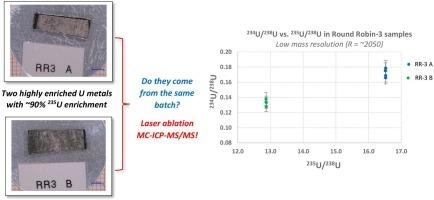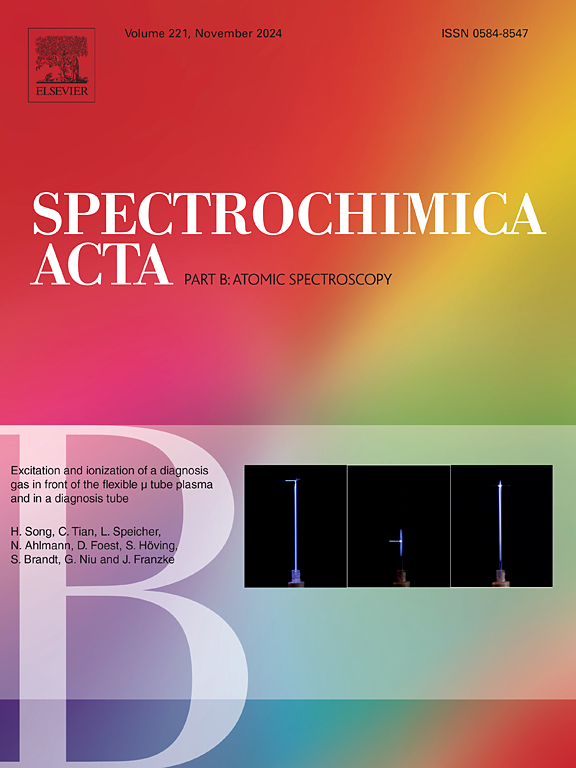Measurement of uranium samples for nuclear forensics by laser ablation multi-collector inductively coupled plasma mass spectrometry using a pre-cell mass filter for collision/reaction cell (MC-ICP-MS/MS)
IF 3.8
2区 化学
Q1 SPECTROSCOPY
引用次数: 0
Abstract
In this paper we present the performance of the newly developed Neoma™ multi-collector inductively coupled plasma mass spectrometry equipped with a pre-cell mass filter for collision/reaction cell (MC-ICP-MS/MS) coupled to laser ablation for nuclear forensics for the first time. The characteristics of the recently introduced MC-ICP-MS/MS instrument are assessed by measuring the U isotopic composition and U isotope ratio spatial distribution. We found that the achieved uranium isotope ratios agree well with the certified values. Furthermore, precisions using the current instrument have considerably improved due to the use of merely Faraday detectors for the analysis, their extended range (up to 100 V) and shorter dwell times (i.e. more data points) besides the multiple collection property of the MC-ICP-MS. The achieved 235U/238U relative combined uncertainty of 0.053 % for low-enriched uranium material using laser ablation is more than one order of magnitude better than using a single collector ICP-MS and approximately 5 times better than the previously reported MC-ICP-MS values. This 235U/238U amount ratio uncertainty is also much better than the recommended International Target Values for low-enriched uranium, which is generally used in nuclear safeguards. The use of higher mass resolution (R = ∼7100) compared to the standard measurement at R = ∼2100 does not worsen significantly the achieved isotope ratio uncertainty. This feature is particularly important for laser ablation studies of confiscated scrap samples or impure nuclear materials in nuclear forensics, where the matrix constituents can highly affect the obtained results. By the coupling the instrument to laser ablation, the overall analysis can be performed in a quasi-non-destructive way in a very short time (within a few hours) and producing practically no radioactive waste in addition. The developed method was applied for two types of tangible illicit nuclear materials (2 highly enriched U metal samples with ∼90 % 235U abundance and 3 low-enriched UO2 samples) for characterization. Due to the improved precision an observable inhomogeneity at micron level was found in UO2 materials, which can further refine the origin assessment. However, this finding has to be taken into account during the reporting of the U isotope abundances. In conclusion, besides its potential in other scientific disciplines, where high precision isotope analysis is required, the established technique using the novel MC-ICP-MS/MS instrument is essential in the security toolkit in nuclear forensic response without considerable alteration of the legal evidence.

碰撞/反应池前质谱过滤器(MC-ICP-MS/MS)激光烧蚀多收集器电感耦合等离子体质谱法测定核取证用铀样品
在本文中,我们首次介绍了新开发的Neoma™多收集器电感耦合等离子体质谱的性能,该等离子体质谱配备了用于碰撞/反应细胞的细胞前质量过滤器(MC-ICP-MS/MS)耦合激光烧蚀用于核取证。MC-ICP-MS/MS仪器通过测量U同位素组成和U同位素比值空间分布来评价其特性。结果表明,铀同位素测定值与核证值吻合较好。此外,由于仅使用法拉第探测器进行分析,其扩展范围(高达100 V)和更短的停留时间(即更多的数据点),除了MC-ICP-MS的多重收集特性外,使用当前仪器的精度也大大提高了。激光烧蚀对低浓缩铀材料的235U/238U相对组合不确定度为0.053%,比使用单一收集器ICP-MS好一个数量级以上,比先前报道的MC-ICP-MS值好约5倍。这种235U/238U量比的不确定度也比通常用于核保障的低浓缩铀推荐的国际目标值要好得多。与R = ~ 2100的标准测量值相比,使用更高的质量分辨率(R = ~ 7100)不会显著恶化所获得的同位素比率不确定度。这一特征对于核取证中没收的废料样品或不纯核材料的激光烧蚀研究尤其重要,因为基质成分会严重影响所获得的结果。通过将仪器与激光烧蚀耦合,可以在很短的时间内(在几个小时内)以准非破坏性的方式进行整体分析,并且几乎不产生放射性废物。该方法应用于两种有形非法核材料(2种235U丰度为~ 90%的高富集U金属样品和3种低富集UO2样品)进行表征。由于精度的提高,在UO2材料中发现了可观察到的微米级不均匀性,这可以进一步细化起源评估。然而,在报告铀同位素丰度时必须考虑到这一发现。总之,除了在需要高精度同位素分析的其他科学学科中具有潜力外,使用新型MC-ICP-MS/MS仪器的现有技术在核法医响应的安全工具包中是必不可少的,而不会对法律证据进行重大更改。
本文章由计算机程序翻译,如有差异,请以英文原文为准。
求助全文
约1分钟内获得全文
求助全文
来源期刊
CiteScore
6.10
自引率
12.10%
发文量
173
审稿时长
81 days
期刊介绍:
Spectrochimica Acta Part B: Atomic Spectroscopy, is intended for the rapid publication of both original work and reviews in the following fields:
Atomic Emission (AES), Atomic Absorption (AAS) and Atomic Fluorescence (AFS) spectroscopy;
Mass Spectrometry (MS) for inorganic analysis covering Spark Source (SS-MS), Inductively Coupled Plasma (ICP-MS), Glow Discharge (GD-MS), and Secondary Ion Mass Spectrometry (SIMS).
Laser induced atomic spectroscopy for inorganic analysis, including non-linear optical laser spectroscopy, covering Laser Enhanced Ionization (LEI), Laser Induced Fluorescence (LIF), Resonance Ionization Spectroscopy (RIS) and Resonance Ionization Mass Spectrometry (RIMS); Laser Induced Breakdown Spectroscopy (LIBS); Cavity Ringdown Spectroscopy (CRDS), Laser Ablation Inductively Coupled Plasma Atomic Emission Spectroscopy (LA-ICP-AES) and Laser Ablation Inductively Coupled Plasma Mass Spectrometry (LA-ICP-MS).
X-ray spectrometry, X-ray Optics and Microanalysis, including X-ray fluorescence spectrometry (XRF) and related techniques, in particular Total-reflection X-ray Fluorescence Spectrometry (TXRF), and Synchrotron Radiation-excited Total reflection XRF (SR-TXRF).
Manuscripts dealing with (i) fundamentals, (ii) methodology development, (iii)instrumentation, and (iv) applications, can be submitted for publication.

 求助内容:
求助内容: 应助结果提醒方式:
应助结果提醒方式:


